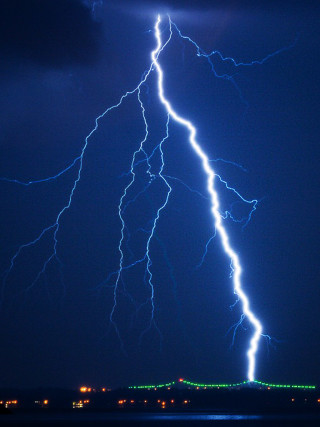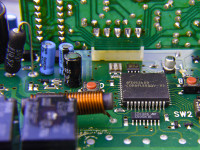It’s no secret Texas has had some crazy rain this year and this got me thinking about lightning protection on the boat. After doing some initial research I came to an ugly truth about lightning protection. If there’s a strike anywhere near my boat, statistically speaking, pretty much all the super cool electronic gadgets that I’ve installed are going to get fried and there’s not a damn thing I can do about it.
I know that is not what you want to hear, but other than luck or you own on a battle ship all your integrated toys are exposed. Even if you disconnect everything, shut off all the breakers, and have fuses on every device, it won’t help. It’s the nature of electromagnetic induction, more on that later. This revelation brings me to the main point of this post, if I can’t protect the boat’s main electronics can I protect my portable backup devices: cell phone, hand-held GPS, portable VHF radio, etc?
Before I get all sciency lets discuss the nature of Lightning. Lightning is nothing but a massive discharge of electrons from a negative potential to a positive potential. There are two key features that concern us: the amount of electrons haul’n ass to their destination and the speed at which that ass haul’n is occurring. When we see lightning we only see the very center where air and water molecules are being super heated into plasma. The secondary part that’s invisible to us, is the electromagnetic field (EMP) radiating out 1000’s of feet 1 around that wispy thin crackle of energy. It’s this unseen daemon that’s attacking our electronics.
Electromagnetic Induction is the principle that electric generators and transformers operate on. If you put a conductive material like wire within a moving magnetic field, as the field passes over it, electrons are disturbed and flow along the wires, VOILÀ Electricity! There’s a whole library of math and study devoted to how all this works. For this post the only thing we need to concern ourselves with is the fact that any conductive material within range of a moving magnetic field will create electricity. Anything from the standing rigging holding up your mast, all the way down to the tiny traces on circuit boards.
Take a minute to let all that sink in… Even if you have disconnected everything, shut all the breakers off, and have fuses on every device. If lightning strikes close enough to your boat; the magnetic field can induce enough current inside any exposed device to kill it!
There’s only one known way to protect your electronics from this massive electromagnetic field, a Faraday cage or shield. “A Faraday cage is an enclosure formed by conductive material or by a mesh of such material.” 2 You’ve encountered them without even realizing it. The metal chassis of most electronics is a Faraday cage. However don’t expect it to do any protection against a lightning strike. Even though it’s a form of a Faraday cage it’s the cheapest implementation the manufacturer could get away with to maintain their Federal Communication Commission class ‘B’ emission standards certification.
Before I get to the solution I implemented on my boat. I’d like to address some of the ad-hoc solutions I came across on the interwebs:
- Reusing anti-static bags: Don’t fall for this, those bags are designed to handle comparably tiny amounts of energy, like that generated by walking across a carpeted floor, which is 1000’s of times below the potential contained within lightning.
- Putting things in the oven: meh… I can’t advise this, the oven while made of conductive metal is designed to manage gas, heat, and fumes. It has many openings for ventilation, hoses, and such. These holes reduce the shielding integrity. If you don’t have any other option it might buy you some luck, but I wouldn’t rely on it.
- Using the microwave: This is not a bad idea the inside of a microwave is a Faraday cage. However it’s a tuned cage, to specifically shield against known and specific wavelengths. I’ll admit I’ve put my cell phone in a microwave and closed the door 3 and had no degradation in cell signal strength. (grain of salt)
- Using Cooking pots: This can work but the pot and lid both need to metal and you need to make sure there’s an insulator between your electronics and the sides of the pot.
- Aluminum Foil: This also works, but make sure there’s an insulating layer between the device and your foil wrap and there can not be any holes. Don’t believe me, wrap your cell phone in aluminum foil and try to call it.
The best option is to have an engineered solution ready to deploy when necessary, for this I keep some EMP bags on the boat. The question everyone asks, “How do you know what makes a good shield and what doesn’t?” Disregarding size there are only two things you need to look for: durability and attenuation.
Anti-static and EMP bags while related have a measurable difference. Anti-static bags have an attenuation of approximately 2-6 decibels (dB) while a specifically designed EMP bag will have an attenuation rating of approximately 35-45dB. What does that mean you ask? Decibels is just a measurement to express the ratio between two physical quantities. To put it more plainly; at point ‘A’ you have 10,000 Sponge Bobs and at point ‘B’ one Sponge Bob, the difference between the two points is 40dB.
If you’re shopping for an EMP bag or container make sure to check the attenuation level (dB) if the manufacturer doesn’t clearly state that value go somewhere else. They’re either being deceitful and trying to pass off cheap items as more expensive products or they don’t understand what they’re selling.
In conclusion if you’re going to be out on the open water and there’s a possibility of running into foul weather, spend the few extra money units to have an EMP case or bags on-board. After you have secured your self and your boat for foul weather gather up all the little devices: laptops, iPods 4, hand held GPS, Radios, cell phones and get them safe. If Zeus throws a bolt at you and takes out your integrated electronics you can feel a little safer knowing you have some backups to get you to a safe harbor or call for help.
Cheers,
Island Rambler
P.S. This is a very complex topic and I have generalized and omitted many tenets and theories in order to stay focused on my topic: protecting your small electronics for disaster recovery.
Notes:
- I could not find a good case study for this reference so I paraphrased based on the mega-amps that have been measured from lightning ↩
- I’m paraphrasing Wikipedia here ↩
- PLEASE NOTE!!! I did NOT turn on the microwave! I just closed the door to tie the door shielding to the rest of the microwave, NEVER microwave a cell phone. ↩
- I consider music almost as important as food & water. ↩











